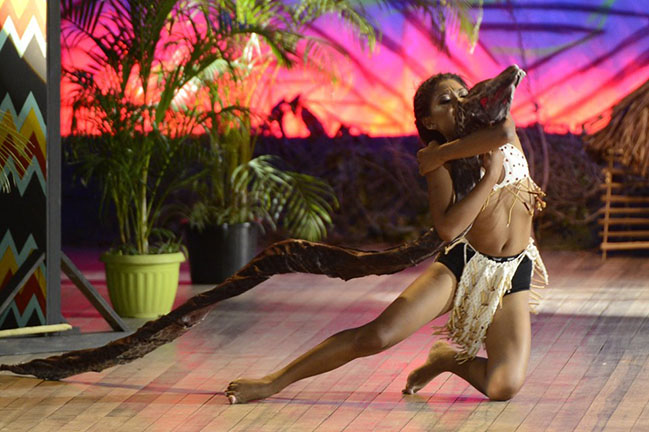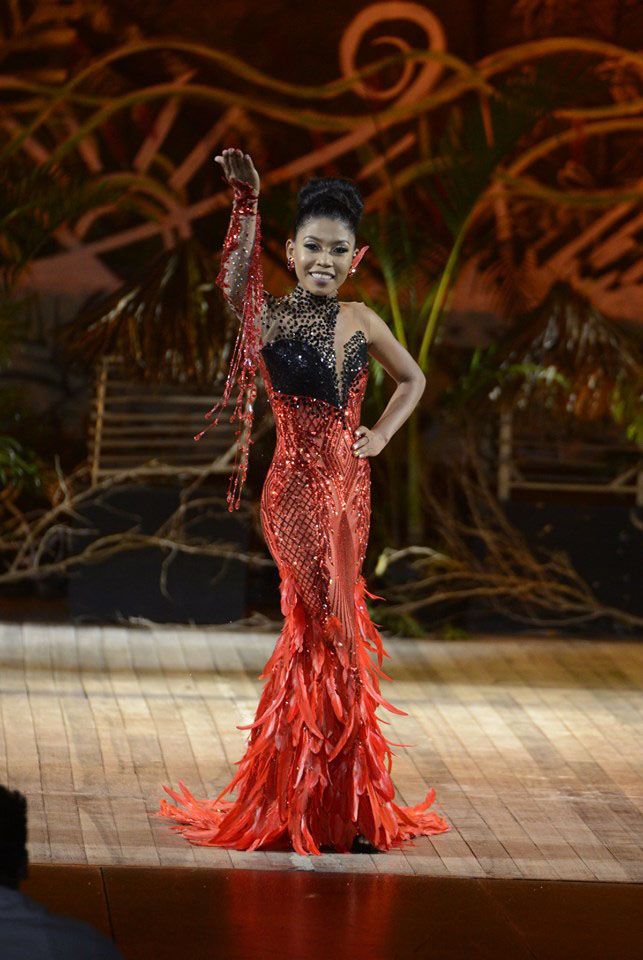Region One’s (Barima-Waini) Esther Marslowe strutted off with the Miss Indigenous Heritage title and crown two Saturdays ago after stiff competition from contestants representing the other nine regions. The other top positions in the pageant went to first runner-up Sauna Fredericks of Region Two (Pomeroon-Supenaam), second runner-up Luana Allicock of Region Nine (Upper Takutu-Upper Essequibo), third runner-up Varshanie Herman of Region Six (East Berbice-Corentyne) and fourth runner-up Jeline Da Silva of Region Seven (Cuyuni-Mazaruni).
A pageant veteran with a deep love for the Indigenous community, Esther was in her element while shining a spotlight on issues affecting her people. Esther has won four pageants before this one, though this was the highest level of competition for her. Among the pageants she won are: Miss Moruca Expo, Miss Region One (Port Kaituma), Miss Region One (Mabaruma), and Miss Indigenous Heritage 2019.

Born at Suddie on the Essequibo Coast, Esther lived for some time in Santa Cruz, Moruca. Her schooling saw her attending Bethany Nursery in Essequibo, St Agnes Nursery in Georgetown, Bethany Primary and Santa Rosa Primary. With her mother being a teacher at the Santa Rosa Secondary School, the pressure was on for her to do well at the National Grade Six Assessment. According to Esther, she was hoping to get Santa Rosa Secondary because it was considered a good school but when her results arrived, she learnt she got St Rose’s High; she was not too excited at the time having never heard of the school. This quickly changed when a letter arrived addressed to her. This, the young woman said, made her feel important and it turned out that she was one of five pupils receiving a scholarship to pursue secondary education at schools in Georgetown.
She soon settled down to dorm life where she stayed throughout her five years at St Rose’s, while she was a sixth former at St Stanislaus College and where she remains even today as she pursues a degree in Environmental Studies at the University of Guyana.
Sharing about her time at St Rose’s High and how it impacted her life, Esther said, “When I was in Region One, I was quite a popular person and I felt pressured. Since then I felt that this popularity thing was not for me and when I came out to attend school, I had promised myself that I’d try as much as I can to not be in the spotlight.

“For the early part of my years at high school I was very reserved; I was an introvert. I would not talk to anybody. I would put my head into my backpack and eat my lunch. A lot of persons, noticing how much of an introvert I was, took this as an opportunity to bully me. It began affecting me and I started eating less, sometimes not at all. Things changed one day when another student called me ‘Buck’ and angered something in me that made me retaliate and hit her.
“At this point, I realized I needed to take advantage of the situation and not let what people think of me or tell me bother me. All these years I was making things harder for myself by not standing up for myself. Today, when someone tries to insult me that way, I am not bothered by it.

“As much as I tried to avoid popularity, I still ended up in the spotlight and became the champion distance runner for St Rose’s High.
“Bullying is an issue I would like tackle during my two-year reign as queen. During my years at the dorms, I’ve observed other younger Indigenous friends face the same situations I did. It’s hard for them to really embrace who they are out here. A lot of us are pressured to adapting to this town life instead of being able to share our culture and talents openly. I know of students at the dorms who arrived in Georgetown knowing their dialects but because of peer pressure, by third form, they stop using the dialects. I would want to use my reign for that purpose also, to encourage them to embrace our dialects and culture.”
Her platform points to the use of the Indigenous languages by coastlanders. And she has already begun making plans to set up clubs in schools where students who know the Amerindian dialects can teach other students. Part of the planning is coming up with fun activities that will make it interesting for persons who do not know the languages. For now, it is a small start Esther said, but noted that it is her dream to someday see all Guyanese afforded the same opportunity.
“I’m given this opportunity to help educate young people and spread awareness about my platform, bring light to certain issues and to be a voice of change,” Esther said.
For this pageant, the young woman competed in two preliminary categories, the first one being the Personality Test and the second, the Indigenous Challenge. Each contestant had to pull a slip of paper that indicated her Indigenous Challenge. Esther’s paper said she had to do tibisiri spinning, something but she had no experience with. However, with basic tips she was able to spin her tibisiri.
The night of the pageant saw the ten contestants competing in the Introduction, Talent, Evening Wear, Cultural Wear and Intelligence categories. For talent, Esther did a dramatic piece about a young person losing her cultural identity and those who knew taking this to their graves. The poem detailed the return of the grandfather spirit who showed her how to prepare the Bina Plant (a charmed plant used to make love, wealth and other potions).
Esther was the recipient of the Evening Wear Award. Her alluring gown which depicted the Scarlet Ibis was designed by renowned Guyanese designer Jason Shurland.
However, Luana carted off the most awards including Best Indigenous Challenge, Best Talent, and Best Traditional Wear. While these wins ensure that she was one of the final five, they could not secure her the crown as each contestant’s scores were erased, leaving the crown and title open to whoever aced the final question.
That question was, what advice would you give to any young Indigenous girl who would like to compete in the pageant? Esther responded that she came from a broken home where she was not fortunate enough to learn as much as she could about the culture and through the pageant, she has gained much knowledge and is able to speak on social issues that matter to her. Taking that into consideration, she said, she would advise any young Indigenous girl to participate in the pageant because it is one with a difference, one that educates contestants on their culture and allows them to bring awareness to social issues. Though there was a grammatical error which the queen claims she is still being crucified for, hers was the best answer and won her the title.
Speaking on her experience, Esther shared that she and the other girls stayed at the Regency Hotel where they bonded and got to know each other well. Being the representative for Region One, she was always up first to do her part during rehearsals and for her she messed up more than the other contestants. Despite the mistakes, her fellow contestants encouraged her to try again. Through the girls she learnt several words in the Arakwak/Lokono, Warrau, Macushi and Wapishiana dialects. The end of their time together, Esther revealed, was emotional.
The Lokono mixed queen enthusiastically expressed that she hopes for bigger things for her people. “I want Indigenous children to know about their rights. I’m actually working alongside the Rights of the Child Commission and have been volunteering with them since 2013. I want to see equity in the educational system, improvement in the health care and transportation sectors. An example, to get from Region One to Georgetown is about $20,000 for airfare. Using the boat is $3,000 and some people might question why people don’t travel via the boat, but that transportation situation is so messed up. There are a lot of young mothers and children travelling. They have to be waiting on the ferry because there isn’t always a scheduled time that they adhere to, so people have to be waiting there all day, sometimes up until midnight before the ferry leaves. The boat is packed and the idea of mothers and children travelling under these strenuous conditions isn’t right; that is a situation that should be addressed immediately. One of the things I also want to work on before my two years are up, is an environmental programme that actually promotes tourism in Indigenous communities.”
The aspiring environmental lawyer posited that she greatly admires Minister of Indigenous Peoples Affairs, Sydney Allicock who she finds to be someone dedicated towards a greater cause. Another of her inspirations is Guyanese scholar, Dr Astell Collins who is always eloquent. Listening to his speeches, she said, is always motivating.
Her ideal person to meet would be singer/songwriter Skip Marley, grandson of the Reggae legend Bob Marley. For Esther, he is an influential young person who wants to make a difference in the world. A collaboration with him, she noted, would make an impact of the world at large. And, just because she couldn’t quite settle on one ideal person, she was allowed two. Her other favourite person is famous actor Jackie Chan.
When she is not working, studying or volunteering, Esther sleeps. However, on vacation breaks in Santa Cruz she loves to sit somewhere quiet surrounded by nature and introspect on her life and how far she has come. An ardent lover of sports she would enjoy a game of volleyball or distance running from time to time.
A devout Christian, Esther, who celebrates her 20th birthday next Friday, is a Seventh Day Adventist who attends La Bonne Intention Seventh Day Adventist Church and is one of the counsellors in the Pathfinder Club.
This Libra describes herself as someone who is quiet, simple and adventurous. Her favourite colours are green, black and white – green for life, white because she has Obsessive Compulsive Disorder and needs to see things clean, and black, just because she likes black and considers it her comfort colour.
Esther’s favourite dish is the pepperpot made with cassava water.
Currently she works with the Food and Agricultural Organisation of the United Nations.






